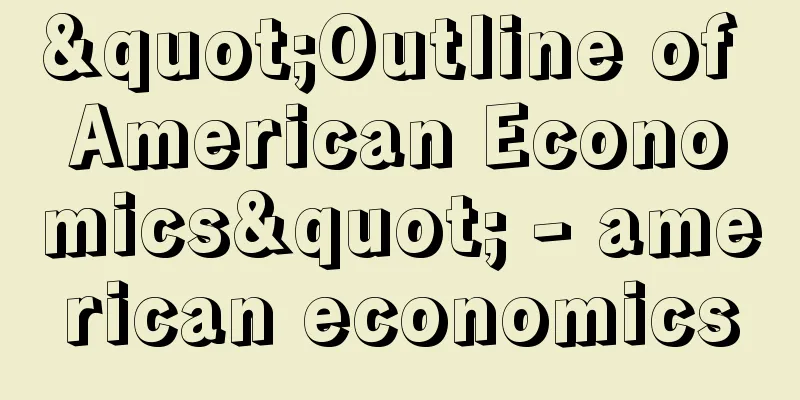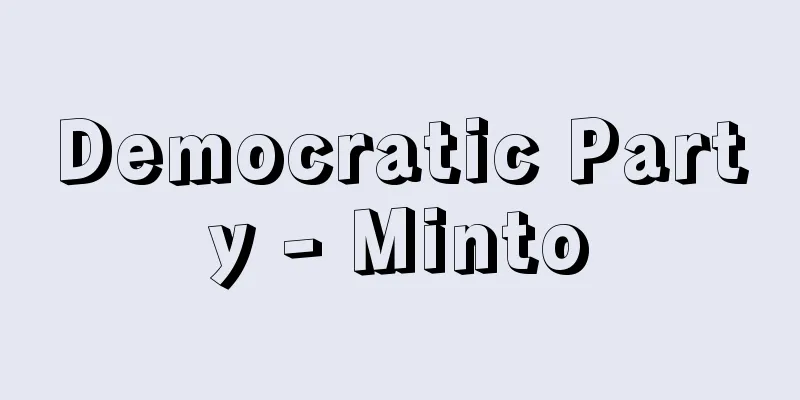Alienation (English spelling)

|
This refers to the situation in which the products of human social activity, such as the products and social relations resulting from labor activity, or the ideas, thoughts, and art resulting from intellectual activity, are self-active, as if endowed with life, and thus appear as if they have their own power, but in contrast to the human beings who produced them, they appear as estranged forces that control him. In this state, human activity becomes external and estranged, which does not belong to the human being himself, and as a result, the human being's essence is removed and his social relations with other human beings are distorted. [Nitagai Kamon] Self-alienationThe basic state of alienation first appears as self-alienation (Selbstentfremdung). The human essence within the human self is alienated (Entäußerung) by human activity. However, the human essence that the self has alienated becomes independent and estranged from the self, and ends up dominating the self. [Nitagai Kamon] Research HistoryThe idea that the self is denied its selfhood and is placed in a state of opposition to its original self originates from German idealism. Fichte recognized this state in the establishment of the not-self (objective world) through the alienation of the ego's activity, while Hegel went beyond Fichte's subjective idealism and considered the objective world (nature) to be an "alienated spirit." In other words, the objectification of the self by the "spirit" was itself alienation. The "spirit" could reach "absolute knowledge" through the process of alienating itself and then regaining it within itself. Therefore, since Hegel considered alienation to be a problem of the "spirit," he also considered it easy to recover from alienation through cognitive activity. Feuerbach pointed out that this Hegelian "spirit" was nothing more than an abstracted and absolutized human essence, like God in Christianity, and saw alienation in this absolutization. In other words, he considered religion to be due to the alienation of the human essence, and idealism to be due to the alienation of reason, and criticized them. But while he uncovered the roots of this alienation, he could not offer any basis for abolishing it. [Nitagai Kamon] Marx's Concept of AlienationMarx critically inherited the ideas of both Hegel and Feuerbach, perfected the concept of alienation, and established the basis of his humanism there. He developed the theory of alienation in his early essay, "Economic-Philosophical Manuscripts" (1844). Here, alienation is understood from four aspects. (1) The objectified product of labor becomes independent of the human subject and appears in opposition to it (alienation from the fruits of labor), (2) labor becomes a means to life rather than an end, and a human life is sought outside of labor (self-alienation), (3) the alienation of the universality of human beings that reduces human existence to a means to an individual's existence (alienation from the species), and (4) the alienation of humans from humans. Marx made it clear that this alienated labor arises from the labor process being carried out as a capitalist production process. From this, Marx addressed the issue of alienation in the commodity world, where the relationship between people is expressed as the relationship between things, and alienation in capitalist production, where labor power becomes a commodity and labor becomes its use value. [Nitagai Kamon] De-alienationThe Marxist position on the elimination of alienation is that in order to eliminate the state of alienation, private ownership and private labor that create alienation must be abolished, and a society based on social ownership of the means of production and directly socialized collective labor must be realized. In contrast, the existentialist position of Sartre and others argues that this alone is not enough. They believe that the final elimination of alienation is impossible (1) as long as there is no end to the situation in which means and resources are relatively scarce compared to the amount needed for the survival of individuals and society as a whole (scarcity), and (2) as long as human practice is in a "state of practical inertia." [Nitagai Kamon] Contemporary Alienation and ResearchIn modern society, the development of technology and the sophistication of capitalism have intensified alienation in labor, alienation seen in the manipulation of the masses through mass communication, and alienation from organizations through bureaucratic control. Not only philosophy, but also sociology and social psychology have addressed the issue of social characteristics that correspond to alienation states. Fromm defined alienation as "a mode of experience in which man experiences himself as an exception" (Escape from Freedom, 1941), and listed four types of social characteristics that respond to alienation: (1) exploitative character, (2) hoarding character, (3) receptive character, and (4) market character. Research has also been conducted to understand alienation as an experience and grasp it empirically. For example, American sociologist Melvin Seeman (1918- ) has observed alienation at the experiential level through survey items such as (1) feelings of powerlessness, (2) meaninglessness, (3) feelings of lack of regulation, (4) feelings of isolation, and (5) feelings of loss of purpose or self-alienation, due to the increase in repetitive and monotonous work processes caused by the automation of factories resulting from the development of modern technology. Because the process of alienation is a phenomenon of society as a whole, it needs to be understood in the context of the interaction between the socio-economic structure and the universal personality structure of individuals. [Nitagai Kamon] "The Philosophy of New Humanism" by Noboru Shirozuka (1972, Japan Broadcasting Publishing Association)" ▽ "Society and Alienation" by Kamon Nitagai (1984, Sekai Shoin)" ▽ "Human Alienation" by Masanori Shimizu (Kinokuniya Shinsho)" ▽ "The Alienation of Modern Man" by F. Pappenheim, translated by Kenzo Awata (Iwanami Shinsho)" [References] | | | | | | | |Source: Shogakukan Encyclopedia Nipponica About Encyclopedia Nipponica Information | Legend |
|
人間の社会活動による産物、たとえば、労働活動による生産物や社会関係、あるいは頭脳活動による観念、思想、芸術などが、それ自身あたかも生命を与えられたように自己活動し、それによって独自の力をもつかのように現れ、それらを生み出した人間自身に対して、逆に彼を支配してしまう疎遠な力として現れるようなことをいう。この状態では、人間の活動は当の人間に属さない外的な、疎遠なものとなり、そのことによって、人間の本質は取り除かれ、また他の人間との社会関係もゆがめられてくる。 [似田貝香門] 自己疎外疎外の基本的状態は、まず自己疎外Selbstentfremdung(ドイツ語)として現れる。人間の自己の内にある人間的本質が、人間的活動によって外化(がいか)Entäußerung(ドイツ語)される。ところが、自己が外化した人間的本質が自己から自立して疎遠となり、逆に自己を支配してしまうに至るのである。 [似田貝香門] 研究史自己が自己であることを拒否され、本来の自己に対立する状態に置かれるという考え方は、ドイツ観念哲学に発する。フィヒテは、この状態を自我の活動の疎外による非我(対象世界)の成立のうちに認め、ヘーゲルは、フィヒテの主観的観念論の立場を超えて、対象世界(自然)は「疎外された精神」だと考えた。つまり「精神」が自己を対象化することがすなわち疎外であったのである。「精神」は、自己を疎外しかつそれを自己のうちに取り戻す作業を通じて「絶対知」に到達できるとした。したがって、ヘーゲルにおいては、疎外は「精神」の問題としてとらえられたので、疎外からの回復も、認識活動によって容易に可能と考えられた。フォイエルバハは、このヘーゲルの「精神」が、キリスト教における神と同様、抽象化され絶対化された人間の本質にすぎないことを指摘し、この絶対化に疎外をみた。つまり、宗教とは人間の本質の疎外によるものであると考え、また観念論は理性の疎外によるものとし、それらを批判した。しかし彼は、こうした疎外の根源を暴いたが、それを廃止する基礎を示しえなかった。 [似田貝香門] マルクスの疎外概念マルクスは、ヘーゲル、フォイエルバハの両者を批判的に継承して、疎外の概念を完成させ、そこに彼のヒューマニズムの基点を据えた。彼の初期の論文「経済学・哲学手稿」(1844)に疎外論が展開された。ここでは疎外は四つの側面から把握されている。 (1)労働の対象化されたものが人間主体から自立し、対立的に現れる(労働の成果からの疎外)、(2)労働は生の目的でなく手段となり、人間らしい生活が労働以外の場に求められる(自己疎外)、(3)人間の存在を個人的な現存の手段にしてしまう人間の普遍性の疎外(類からの疎外)、(4)人間の人間からの疎外。この疎外された労働は、労働過程が資本家的生産過程として行われることから生じることを明らかにした。ここからマルクスは、人と人との関係が物と物との関係として表される商品世界における疎外と、労働力が商品となり労働がその使用価値となる資本主義的生産における疎外とを問題にしていった。 [似田貝香門] 疎外解除疎外状態を取り除くには、疎外を生み出す私的所有と私的労働を廃棄して、生産手段の社会的所有と直接に社会化された共同労働に基礎を置く社会を実現すべきであるとするのがマルクス主義の疎外解除の立場である。これに対し、サルトルらの実存主義の立場では、それだけでは十分でないとする。(1)手段や資源が個人や社会全体の存続に必要な量に対して相対的に不足しているような事態(希少性)がなくならない限り、(2)人間の実践が「実践的惰性態」のなかにある限り、疎外の最終的な解除は不可能とみた。 [似田貝香門] 現代における疎外と研究現代社会においては、テクノロジーの発展と資本主義の高度化によって、労働における疎外、マス・コミュニケーションを通じての大衆操作にみられるような疎外、官僚支配による組織からの疎外などが深化してきている。哲学ばかりでなく、社会学や社会心理学は疎外状態に対応する社会的性格を問題にした。フロムは疎外を「人間が自分自身を例外者として経験する経験様式」(『自由からの逃走』1941)と規定し、疎外への対応としての社会的性格として、(1)搾取的性格、(2)貯蓄的性格、(3)受容的性格、(4)市場的性格の四つの類型をあげている。疎外を経験としてとらえ、それを実証的につかむ研究も行われてきた。 たとえばアメリカの社会学者シーマンMelvin Seeman(1918― )は、現代のテクノロジーの発展による工場のオートメーション化によって、作業工程で単純作業や単調労働が増加することから、(1)無力感、(2)無意味さ、(3)無規制感、(4)孤立感、(5)目的喪失感または自己疎外感などの調査項目から経験レベルでの疎外をとらえた。疎外の過程は全体社会の現象であるから、それを社会経済構造と普遍の個人の性格構造との相互作用において把握する必要がある。 [似田貝香門] 『城塚登著『新人間主義の哲学』(1972・日本放送出版協会)』▽『似田貝香門著『社会と疎外』(1984・世界書院)』▽『清水正徳著『人間疎外論』(紀伊國屋新書)』▽『F・パッペンハイム著、粟田賢三訳『近代人の疎外』(岩波新書)』 [参照項目] | | | | | | | |出典 小学館 日本大百科全書(ニッポニカ)日本大百科全書(ニッポニカ)について 情報 | 凡例 |
Recommend
Kawagoe
...It stretches from the northern end of the Musa...
Functional uterine bleeding
This is a condition in which bleeding occurs from ...
Mitsuda Sou - Mitsuda Sou
One of the color names. Used in murals since ancie...
Semi-precious stone (English spelling)
...Therefore, even if artificial crystals, or syn...
Ukiyobukuro - Ukiyobukuro
〘Noun〙 A bag that was popular in the early modern ...
"Kasumi-Kokushu"
…However, his complete works, including his maste...
aside
Aside: A side remark made during a theatrical perf...
precious metal
...Chemically, it occurs as an element, has a low...
Aki Toji - Aki Toji
...Mitsu, the central settlement, has long flouri...
Group psychotherapy
A general term for attempts to use group settings ...
Gigeiten
A Buddhist deity. A celestial maiden born from th...
Kishigawa [town] - Kishigawa
A former town in the Naka district in northern Wak...
F Plan - F Plan
…In the UK, there are two levels of planning base...
Horonobe [town] - Horonobe
A town in Teshio County in northern Hokkaido. The ...
Ominato Bay - Ominatowan
A bay in the bend of the Shimokita Peninsula in t...
![Oyama [town] - Oyama](/upload/images/67cb23135f253.webp)








